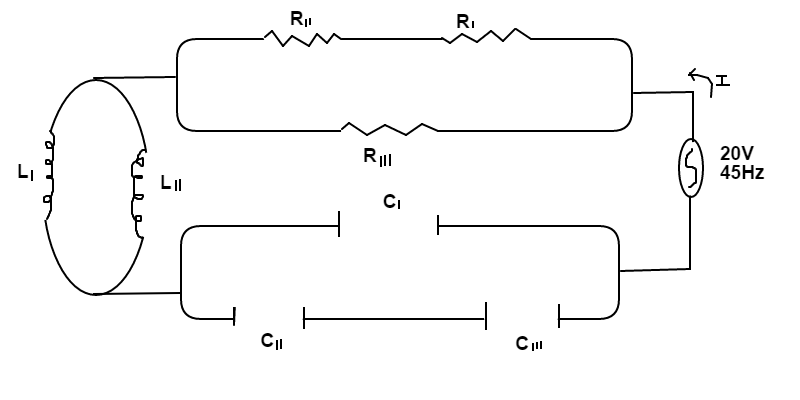RLC Circuit Current Determination

An RLC circuit was prepared with an AC power supply that has a voltage ( V s ) of 2 0 V and a frequency ( f ) of 4 5 H z . The circuit consists of resistors ( R ), capacitors ( C ), and inductors ( L ). The resistor resistances are as follows: R I = 2 Ω , R I I = 4 Ω , and R I I I = 3 Ω . The inductors have the following inductances: L I = π 4 H and L I I = π 1 2 H . The capacitors have these capacitances: C I = π 3 0 μ F , C I I = π 9 0 μ F , and C I I I = π 1 8 0 μ F .
What is the peak current ( I ) of this circuit in m A ?
David's Electricity Set
This section requires Javascript.
You are seeing this because something didn't load right. We suggest you, (a) try
refreshing the page, (b) enabling javascript if it is disabled on your browser and,
finally, (c)
loading the
non-javascript version of this page
. We're sorry about the hassle.
1 solution
When you see 8 1 2 3 5 2 3 0 7 8 6 , you'd think you've done something wrong somewhere. :P
Log in to reply
very true, I was clicking the answer having very heavy fingers.
This is unfair.No battery produces an ac current.I spend a lot of time trying to do it through DC supply.
Log in to reply
Yeah, the image might mislead you into using DC, may be the battery should be changed. Anyway, the problem states that the voltage has certain frequency so it should be obvious that it is an AC circuit.
for peak current you should multiply underroot 2 to your answer.as voltage provided are rms values otherwise stated.
This is wrong. When nothing is given you take RMS as 20.
R I , I I = R I + R I I = 2 + 4 = 6 Ω R c i r c u i t = ( R I I I 1 + R I , I I 1 ) − 1 = ( 3 1 + 6 1 ) − 1 = ( 2 1 ) − 1 = 2 Ω
L c i r c u i t = ( L I 1 + L I I 1 ) − 1 = ( 4 π + 1 2 π ) − 1 = ( 3 π ) − 1 = π 3 H
C I I , I I I = ( C I I 1 + C I I I 1 ) − 1 = ( 9 0 π + 1 8 0 π ) − 1 = ( 6 0 π ) − 1 = π 6 0 μ F C c i r c u i t = C I + C I I , I I I = π 3 0 + π 6 0 = π 9 0 μ F
X L = 2 π f L c i r c u i t = 2 π ( 4 5 H z ) ( π 3 H ) = 2 7 0 Ω X C = 2 π f C c i r c u i t 1 = 2 π ( 4 5 H z ) ( π 9 0 × 1 0 − 6 F ) 1 = 8 1 1 0 0 0 0 Ω Z = R 2 + ( X L − X C ) 2 = 2 2 + ( 2 7 0 − 8 1 1 0 0 0 0 ) 2 = 8 1 2 3 5 2 3 0 7 8 6 Ω
I = 8 1 2 3 5 2 3 0 7 8 6 Ω 2 0 V = 4 0 5 1 7 6 1 5 3 9 3 2 ≈ 0 . 1 3 6 A = 1 3 6 m A ⇐ A n s w e r